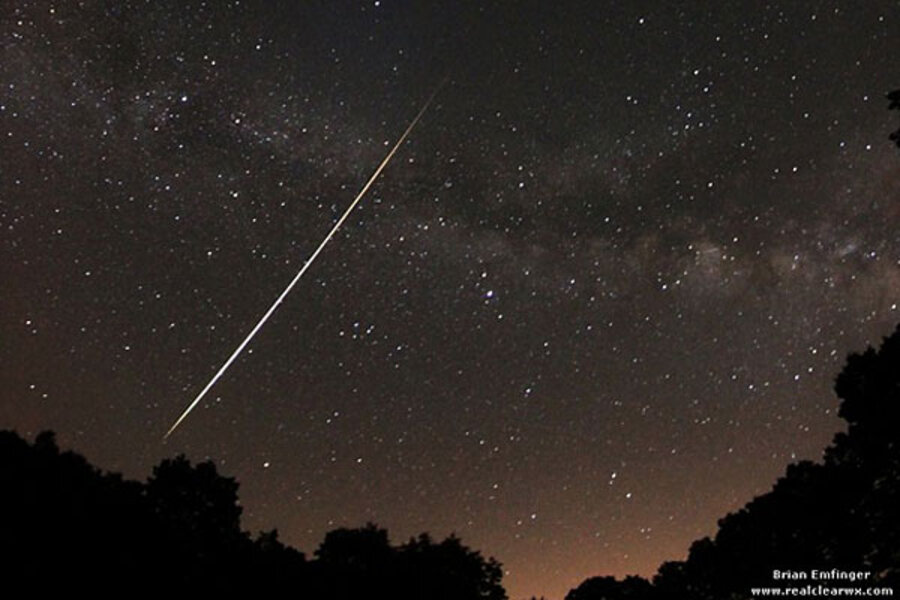Lyrid meteor shower lights up sky around world
Loading...
The Lyrid meteor shower amazed some skywatchers around the world with bright celestial fireworks this weekend, thanks in part to the lack of a bright moon.
The annual April "shooting star" display hit its peak in the wee hours of Sunday (April 22) while the moon was in its dark, new phase, offering observers with clear weather a better chance to spot the Lyrid meteor shower without the interference of bright moonlight.
"Clear skies, no moon, a bit chilly, but otherwise perfect. I saw two meteors shortly after sunset," photographer Bill Allen of Ralph, Saskatchewan in Canada told SPACE.com in an email.
Allen snapped a striking snapshot that captured a Lyrid with green northern lights in the background. "The aurora added to what was already a great night," Allen said. [Spectacular 2012 Lyrid Meteor Shower Photos]
Allen wasn't the only lucky observer to witness the Lyrids this weekend. Photos sent in to SPACE.com from skywatchers in California, Malaysia and other spots around the world reveal striking views of bright Lyrid meteors.
Skywatcher Brian Emfinger of Ozark, Ark., captured a magnificent fireball that created a spectacular sight through his fish-eye lens-equipped camera. The bright stars of our Milky Way galaxy serve as a backdrop in Emfinger's view.
Photographer Marian Murdoch in Ridgecrest, Calif., also reported several bright Lyrids during this year's display, but sadly the best show of the night escaped her lens.
"There was a HUGE fireball that we observed, low on the horizon, but (of course) it was out of my field of view with the camera, Murdoch told SPACE.com via email. "Some of the meteors were very dim, and were not even seen with the human eye. Only after I brought them up on the computer was I able to see them."
The Lyrid meteor shower has been observed by humans for more than 2,600 years and occurs each year in mid-April when the Earth passes through a stream of dust left behind by the comet Thatcher (C/1861 G1). The comet dust can reach speeds of up to 110,000 mph (177,027 kph) as it slams into Earth's atmosphere, causing it to ignite as dazzling meteors.
NASA scientists predicted an impressive Lyrid meteor display this year because of the shower's timing coincided with the new moon. A confluence of two other events also enhanced the meteor shower for NASA.
First, scientists developed a special meteor camera designed to photograph fireballs while dangling from a weather balloon flying in the stratosphere. A team of students from Union High School and Home Street Middle School in Bishop, Calif., launched the camera-equipped balloon late Saturday night (April 21). The second event occurred in space; the Lyrids were expected to be visible to astronauts on the International Space Station.
NASA meteor expert Bill Cooke at the agency's Marshall Space Flight Center in Alabama coordinated efforts to track meteors on the ground, by the student balloon and by station astronauts to create an unprecedented look at the Lyrid meteor shower. The Marshall center posted video and images of the student balloon launch online, along with camera views of Earth from the station, but whether Lyrid meteors were actually seen by astronauts remains to be seen.
In Kulim, Kedah, Malaysia, skywatcher Veerayen Mohanadas also snapped amazing views of the Lyrid meteor shower.
"It seems very special to me when seeing the 'shooting star' coming from star Vega," Mohanadas said.
Cooke also led an NASA webchat and video stream on the agency's website that provided live views from meteor cameras for observers plagued by bad weather.
Cooke said the Lyrid meteor shower is the second notable meteor display of the year, but the pace is about to pickup.
In May, the Eta Aquarids — one of two annual meteor showers created by remnants of the famed Halley's comet — will peak between May 5 and 6, according to a NASA guide.
You can follow SPACE.com Managing Editor Tariq Malik on Twitter @tariqjmalik. Follow SPACE.com for the latest in space science and exploration news on Twitter @Spacedotcom and on Facebook.
- Meteor Shower Mania: How Well Do You Know 'Shooting Stars'?
- 2012 Meteor Shower Skywatching Calendar
- Star Charts, Sky Maps and Skywatching Guides
Copyright 2012 SPACE.com, a TechMediaNetwork company. All rights reserved. This material may not be published, broadcast, rewritten or redistributed.







